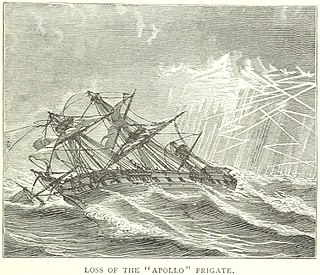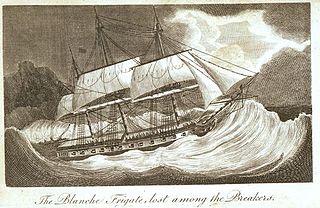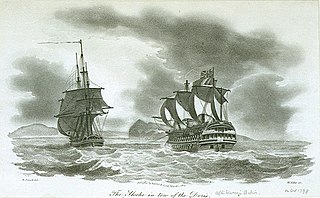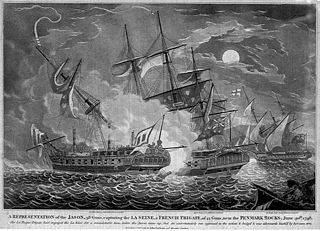HMS Orestes was an 18-gun Dutch-built brig-sloop of the Royal Navy. She was originally built as the privateer Mars, and was captured by the British in 1781. She went on to serve during the Fourth Anglo-Dutch War and the French Revolutionary Wars.

HMS Babet was a 20-gun sixth-rate post ship of the British Royal Navy. She had previously been a corvette of the French Navy under the name Babet, until her capture in 1794, during the French Revolutionary Wars. She served with the British, capturing several privateers and other vessels, and was at the Battle of Groix. She disappeared in the Caribbean in 1800, presumably having foundered.

HMS Apollo, the fourth ship of the Royal Navy to be named for the Greek god Apollo, was a fifth-rate frigate of a nominal 36 guns. She was the name ship of the Apollo-class frigates. Apollo was launched in 1799, and wrecked with heavy loss of life in 1804.
Fifteen ships of the Royal Navy have borne the name HMS Ranger

Minerve was a 40-gun Minerve-class frigate of the French Navy. The British captured her twice and the French recaptured her once. She therefore served under four names before being broken up in 1814:

HMS Amfitrite was a 38-gun fifth-rate frigate of the Royal Navy. She had previously served with the Spanish Navy before she was captured during the Napoleonic Wars and commissioned into the Royal Navy. The Admiralty renamed her HMS Blanche after she had spent just over a year as Amfitrite. She was the only ship in the Navy to bear this specific name, though a number of other ships used the conventional English spelling and were named HMS Amphitrite. Her most notable feat was her capture of Guerriere in 1806. Blanche was wrecked in 1807.
Coquille was a 40-gun frigate of the French Navy, lead ship of her class, and launched in 1794. The Royal Navy captured her in October 1798 and took her into service as HMS Coquille, but an accidental fire destroyed her in December 1798.
Vénus was a corvette of the French Navy that the British captured in 1800. Renamed HMS Scout, she served briefly in the Channel before being wrecked in 1801, a few days after taking a major prize.

HMS Doris was a 36-gun fifth-rate frigate of the Royal Navy, launched on 31 August 1795. which saw service in the French Revolutionary and Napoleonic Wars. Doris was built by Cleveley, of Gravesend.
Sixteen ships of the Royal Navy have borne the name HMS Viper, or HMS Vipere, after the members of the Viperidae family:

HMS Castor was a 32-gun Amazon-class fifth-rate frigate of the Royal Navy. She served during the French Revolutionary and Napoleonic Wars. The French briefly captured her during the Atlantic Campaign of May 1794 but she spent just 20 days in French hands as a British ship retook her before her prize crew could reach a French port. Castor eventually saw service in many of the theatres of the wars, spending time in the waters off the British Isles, in the Mediterranean and Atlantic, as well as the Caribbean.

HMS Jason was a 38-gun Artois-class fifth-rate frigate of the Royal Navy. She served during the French Revolutionary Wars, but her career came to an end after just four years in service when she struck an uncharted rock off Brest and sank on 13 October 1798. She had already had an eventful career, and was involved in several engagements with French vessels.

Seine was a 38-gun French Seine-class frigate that the Royal Navy captured in 1798 and commissioned as the fifth-rate HMS Seine. On 20 August 1800, Seine captured the French ship Vengeance in a single ship action that would win for her crew the Naval General Service Medal. Seine's career ended in 1803 when she hit a sandbank near the Texel.

HMS Magnet was a Cruizer-class brig-sloop built at Robert Guillaume’s yard at Northam and launched in 1807. She served in the Baltic, where she took two prizes, one an armed privateer, before wrecking in 1809.
HMS Alcmene was a 32-gun Alcmene-class fifth rate of the Royal Navy. This frigate served during the French Revolutionary and Napoleonic Wars under the command of several notable officers. Alcmene was active in several theatres of the war, spending most of her time cruising in search of enemy vessels or privateers, and escorting convoys. She fought at the Battle of Copenhagen in 1801 and served in the blockade of the French coasts during the later Napoleonic Wars until she was wrecked on the French coast in 1809.
HMS Orpheus was a 32–gun fifth rate frigate of the Royal Navy. She was launched in 1780, and served for more than a quarter of a century, before she was wrecked in 1807.

La Réunion was a 36-gun French warship launched in 1786. During the French Revolutionary War she was stationed at Cherbourg and was successfully employed harassing British merchant shipping in the English Channel until the British captured her off the Cotentin Peninsula during the action of 20 October 1793. Renamed HMS Reunion, she served for three years in the Royal Navy helping to counter the threat from the new Batavian Navy, before she was wrecked in the Thames Estuary in December 1796.

HMS Barbuda was commissioned into the Royal Navy in 1780 after having briefly served as an American privateer. Barbuda was one of the two sloops that captured Demerara and Essequibo in 1781, but the French Navy captured her there in 1782 and took her into service as Barboude. The French Navy sold her to private owners in 1786, and she served briefly as a privateer in early 1793 before the French Navy purchased her again and named her Légère. She served them until mid-1796 when the Royal Navy captured her and took her into service as HMS Legere. She was wrecked off the coast of Colombia, without loss of life, in February 1801.
His Majesty's hired armed lugger Venus, which was renamed Agnes in 1804, served the British Royal Navy from 8 March 1804 until she foundered in the Texel in March 1806.

HMS Jason was a 36-gun fifth-rate Penelope-class frigate, launched in 1800. She served the entirety of her career in the English Channel, mostly in the frigate squadron of Commodore Charles Cunningham. Serving off the coast of France, especially around Le Havre and Cherbourg, she captured several French privateers and recaptured a British merchant ship in a cutting out expedition. Having only been in commission for around fifteen months, Jason was wrecked off the coast of St Malo on 21 July 1801. Her crew were saved and later exchanged, and in August her wreck was burned to prevent the French from rescuing it.











